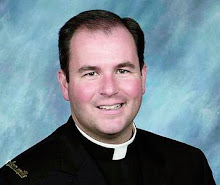 Dear friends in Christ,
Dear friends in Christ,When writing blogs and emails to our contacts, I always end with the phrase "may you remain close to the Sacred Heart of Jesus through the Immaculate Heart of Mary". It dawned on me that perhaps you may not know about the Sacred Heart of Jesus, so I thought I would do some writing on it.
The devotion to the Sacred Heart of Jesus is exactly what it sounds like: it is a devotion to the physical heart of Jesus. It is a realization of the divine love of Jesus for humanity. But why is the Sacred Heart such a realization?
The Sacred Heart of Jesus has its origins on the cross, when Jesus was crucified. Jesus died for our sins, and you can say that his death was the ultimate reparation of sins. A reparation is a re-payment, so when you are talking about reparation in the religious sense, it is an action that someone does in order for someone else to return to God. The ultimate reparation then, was the crucifixion of Jesus, because He did it for us, because of the love that He has for us. According to Wikipedia, the devotion to the Sacred Heart of Jesus is closely associated with acts of reparation to Jesus Christ. Pope Pius XI wrote: "the spirit of expiation or reparation has always had the first and foremost place in the worship given to the Most Sacred Heart of Jesus". This is from his encyclical Miserentissimus Redemptor, written in 1928.
The Sacred Heart is a realization of the diving love for man because it shows us that Jesus, who we know as God, was crucified out of love for us. He loved us so much that he gave Himself up for the sake of our salvation. From the cross comes salvation, made possible by the crucifixion of Christ.
There is also a sacramental relationship that the Sacred Heart has. On the Cross, one of the Roman soldiers thrust his lance into the side of Jesus. We read this in the Gospel of John: "When they came to Jesus and saw that he was already dead, they did not break his legs, but one soldier thrust his lance into his side, and immediately blood and water flowed out" (John 19:33-34). The early Church fathers picked up an important sacramental point made here, that blood and water flowed out. So from the side of Jesus, comes forth the sacraments, and from the side of Jesus comes forth the Church, which administers the sacraments. The blood of Christ poured forth, so when we celebrate the Mass, we celebrate the Eucharist, which is truly the Body and Blood of Jesus. Think about this: the same Blood of Christ that was poured forth from His precious side is the same Precious Blood we have at Mass. The Water is the water of Baptism, which wipes away the stain of Original Sin, so how appropriate it is to have the waters of Baptism flow from the side of the Crucified One, the Christ who died to save us from our sins!
This Precious Blood that poured forth from Jesus' side was at one point in Jesus' Sacred Heart, but tradition also tells us, and this devotion, that the lance of the soldier actually pierced his Sacred Heart, so the blood literally poured forth from the heart of Jesus. This is why the actual image of the Sacred Heart is shown with a lance-wound. It is also shown with a crown of thorns, which alludes to Jesus' Passion. So the image itself points to the death of Christ.
So the Sacred Heart has a reparative aspect, as devotion to it is used as a means of reparation for the sins of others who may desecrate Churchs or abuse the sacraments, for example. It also points to the cross, and the fact that the Crucifixion of Christ saved us from sins and won our salvation, so the image is a realization of the divine love that God has for humanity. And finally, this is especially realized in the sacrament character of the Sacred Heart. From the side of Jesus poured forth blood from His heart and water, two life-giving symbols that Jesus turned into signs of salvation.

This is an image of St. Marguerite Marie Alacoque, who had visions of the Sacred Heart of Jesus. She lived in France in the 17th Century. She would often have visions of Jesus growing up, and she thought they were part of the normal experience of life. She became a nun, and Jesus continued to reveal Himself to her. She eventually was allowed to build a chapel to the Sacred Heart of Jesus in her convent. She was the first person to start devotion to the Sacred Heart, but the devotion was not recognized until 75 years after her death. The devotion was propogated by the Jesuits after her death.

This is a picture of St. Faustina Kowalska, who is a 20th Century Saint who lived in Poland. She spread devotion to the Mercy of God, often called Divine Mercy. In many Divine Mercy images, the mercy flows forth from the Sacred Heart of Jesus. Below, I have included an image of the Divine Mercy. The Polish at the bottom is translated: "Jesus, I trust in you". Jesus revealed to her that He wanted her to spread deovtion to Divine Mercy, and so she had an image drawn, and her dairy was eventually published. She also started the popular Chaplet of Divine Mercy, which is a recitation of the following prayer: "For the sake of His sorroful passion, have mercy on us and on the whole world", which is prayed on the Rosary beads. For information on how to pray it, this is a link to instructions on how to pray it. For those of you discerning your vocation, whatever it may be, it will be a great practice to begin praying the Divine Mercy Chaplet, as this Divine Mercy flows from the Sacred Heart of Jesus.
May you always remain close to the Sacred Heart of Jesus through the Immaculate Heart of Mary. May God continue to bless you and may you remain close to Him and His Holy Catholic Church.
St. John Vianney, pray for us.
St. Margaret Mary Alocoque, pray for us.
St. Faustina, pray for us.
Posted by Bobby Murphy

2007-08-16.jpg)






No comments:
Post a Comment